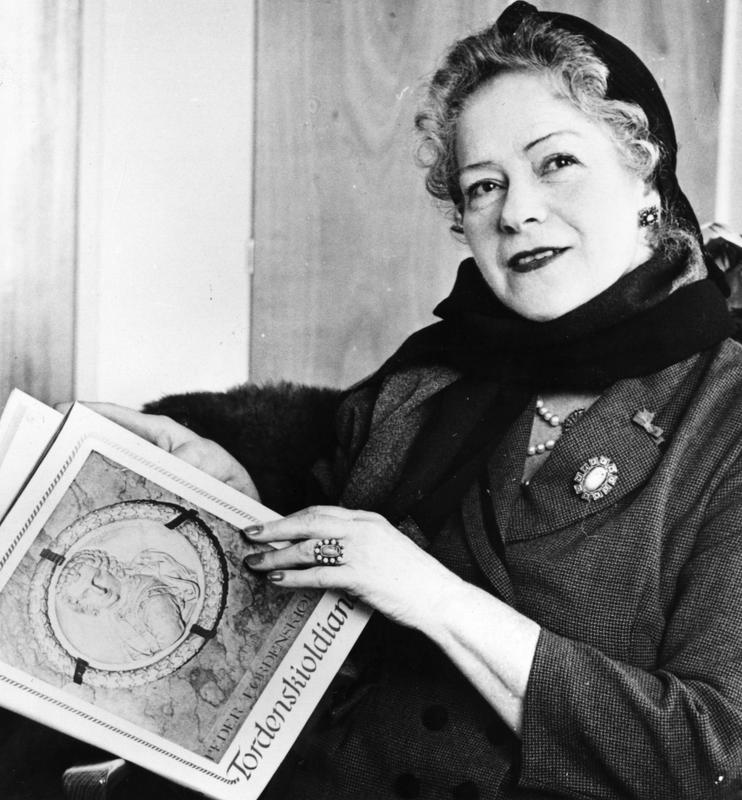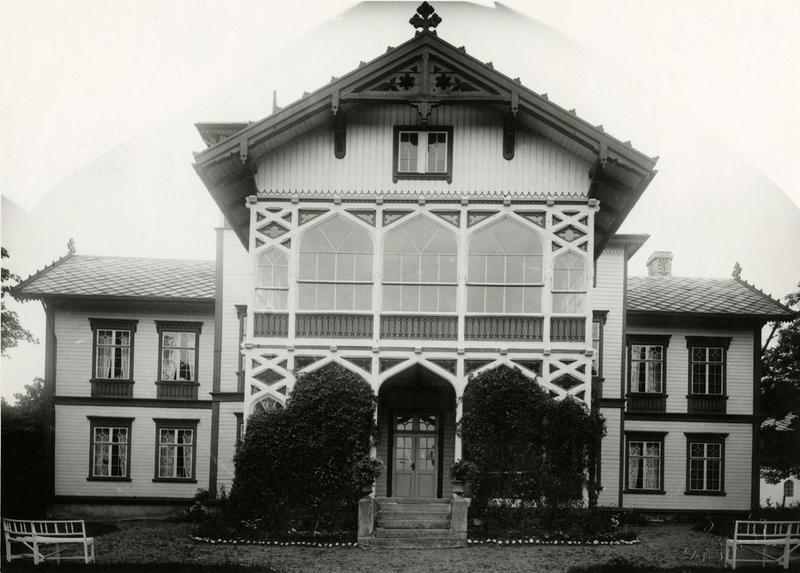-
Ringve farm around 1940 Ringve Museum
Majestic on a hill on the Lade peninsula just north-east of Trondheim centre sits the country estate of Ringve, surrounded by Ringve Botanical Garden, with a beautiful view over the Trondheimsfjord. From the main gate the old drive snakes through the landscaped park until you are greeted by the stately main building in white and yellow ochre. Today Ringve is an oasis in an area of traffic, light industry, businesses and housing, and most visitors arrive by bus or car. But only a few generations ago it was the country houses, drives, gardens and fields that dominated the entire cultural landscape of Lade.
Victoria Bachke – creator of Ringve Museum
The name Victoria Bachke (1896-1963) will forever shine in Ringve’s history. She was the museum’s founder and first director. Without her zeal and determination, the old country estate would never have become the cultural centre it is today.
Victoria Bachke was born in the Russian seaside resort of Kranz, where her parents Michael and Sophie Rostin holidayed every summer. Michael was a specialist bridge-builder with the Russian state railways. The children were often allowed to accompany him on his many journeys. The beautiful travel cutlery set Victoria inherited from her father had surely seen good use then.Their home was prosperous and the children received a good bourgeois education, speaking French and German and learning music. Several of Victoria’s siblings became professional musicians, and she herself was a skilled vocalist.
In March 1914 Victoria left Moscow in the company of her older sister Valentine, who had just begun her career as an opera singer. Some months later we meet them in Switzerland, where Victoria had probably been admitted to one of Leysin’s famous TB sanatoria.They had intended to go home after the treatment, but then the Great War broke out and they lost contact with the family in Russia. A younger brother of Michael Rostin had become an engineer and lived in Oslo. It is probable that Victoria spent the rest of the war with his family, while Valentine toured as a singer and participated in benefit concerts all over the Nordic countries for Russian refugees. In the autumn of 1916 Valentine gave her first performance in Trondheim, and soon married Morten Svendsen the concert-master at the city theatre. In 1919 little sister Victoria, who was now of age, came to visit and had her first meeting with Ringve and the 23 years older Christian Bachke.
As the Lady of Ringve,Victoria’s life was secure and without care. She liked to travel, especially in the dark winter months, while Christian stayed home and managed the business. But they wrote to one another; almost daily letters flew between Trondheim and Victoria’s lodgings in Nice, Florence or Aachen (where Valentine had moved to start a singing school). “Dearest little Vita,”Christian would begin;“My very dearest husband, my Christusha”, Victoria replied in her flowery but not always correct Norwegian. She had friends and acquaintances everywhere, she was always on the go; parties, restaurants, excursions. In these years she created a network of people who came in handy when the museum was to be realised. In 1920 she was reunited with her father who was now a widower. Together with two of his sons and his daughter Serafima he had fled Revolutionary Moscow and found a new home in Germany. Serafima, a harpist, soon made a name for herself with several big orchestras. But before the next war was over, Victoria was to lose them all, to either sickness or accidents.
- 1/1
Victoria Bachke.
The Second World War was difficult for the Bachkes. They were told of plans to demolish Ringve; houses and trees had to go because they were in the way of an airstrip laid out on the Lade plain just next door. Victoria made use of all her charm and cunning to save the manor, and it was rumoured in the city that the couple were collaborating with the German occupiers.Victoria later described how this difficult situation brought the couple even closer together.When Christian died in 1946, Victoria needed something to fill her days with.
The work on the museum was her debt of gratitude to her husband and it was with an admirable determination that she began its creation.The newspapers were soon full of articles about the energetic lady of Ringve who brought back the weirdest musical instruments from her travels in Norway and abroad. As a collector Victoria Bachke was ruthless – so famous for her haggling that the antiques dealers of Copenhagen got on the bush telegraph whenever she came to town. If there was something that she wanted, she didn’t give up, but used all her charm, endurance and powers of persuasion. She went everywhere and had a gift for tracking down instruments and other objects in their hiding-places. Not everyone liked her methods, but without Victoria’s special personality there would never have been a music museum at Ringve.
There are many stories about the instruments that Victoria brought home.The best-known is the one about the ‘Versailles harpsichord. In May 1953 she returned from what the papers called a nine-week ‘safari’ in Italy and France, her luggage bulging with exciting instruments. Pride of place went to a beautiful 18th-century harpsichord she had found in Paris, at the home of the widow of a French music professor. It had once been in a Swiss castle, but had since been lent to the Hall of Mirrors in Versailles for use in concerts.This she had to have! Today it is on display in “The Museum in the Barn”.
Victoria was her own best mythologist.The story of the ‘Versailles harpsichord’ is typical.They were soon saying that it had belonged to the Sun King himself, Louis XIV, and that Victoria had smuggled it out of France. She did nothing to quash the rumour, but threw out her arms and exclaimed, “What will a woman not do for love!”
On another occasion she came home with a plaster-of-Paris cast of Chopin’s face and left hand. It was well boxed and together with her other trophies filled the train compartment.When the train crossed the Norwegian frontier, the following conversation is said to have taken place between Victoria Bachke and an innocent customs inspector.“Is all this yours?” asked the inspectors, peering into the compartment. She nodded.The customs man pointed to a box and asked what was in it. “Oh, in that one I have Chopin’s hand”. Asked what was in the next box, she replied just as snappily, “Yes, that one contains Chopin’s head”. The inspector retreated!
Victoria still dreamt of the Motherland. In the early summer of 1963 she received an invitation from the Soviet Ministry of Culture to come as a guest to Moscow. She left that August, by train via Leningrad. She described her stay in her homeland as an adventure, with visits to museums and exciting evenings of ballet, opera and theatre. But the greatest experience was the reunion with her two sisters Elisabeth and Julia, whom she had not seen for almost 50 years. Her own account of their first meeting is very moving.
She returned to Trondheim grateful and full of impressions. The circle was closed, she had got her family back.Victoria Bachke had peace of mind.On 19 November that year she died of a heart attack – an exciting, eventful and hard-working life was at an end.Victoria Bachke’s ashes rest in an urn in Ringve park.
- 1/2
- 2/2



